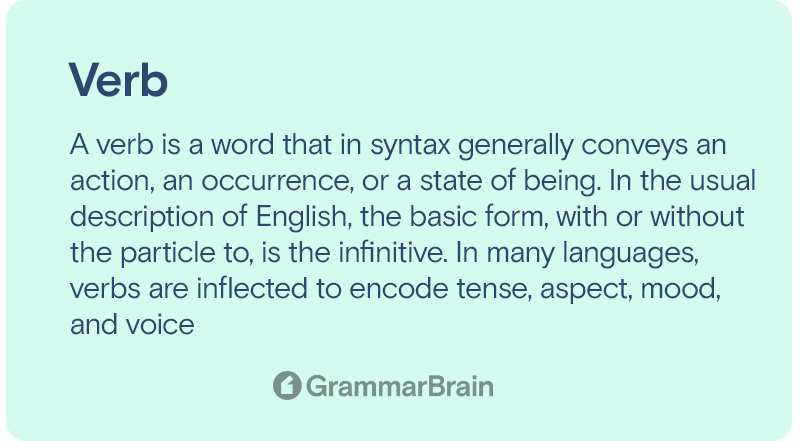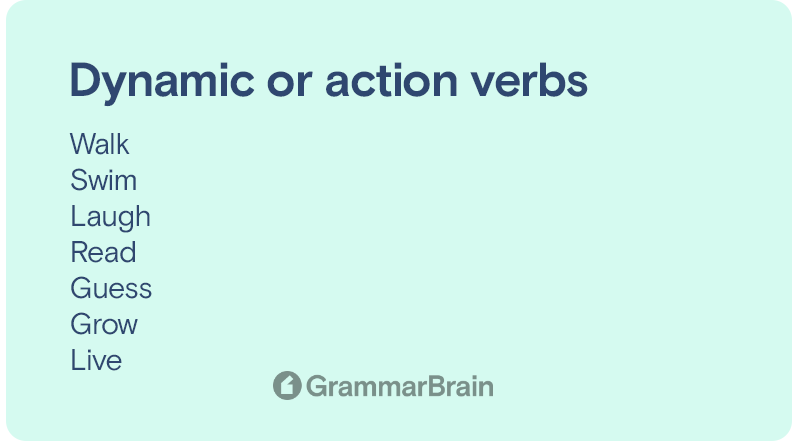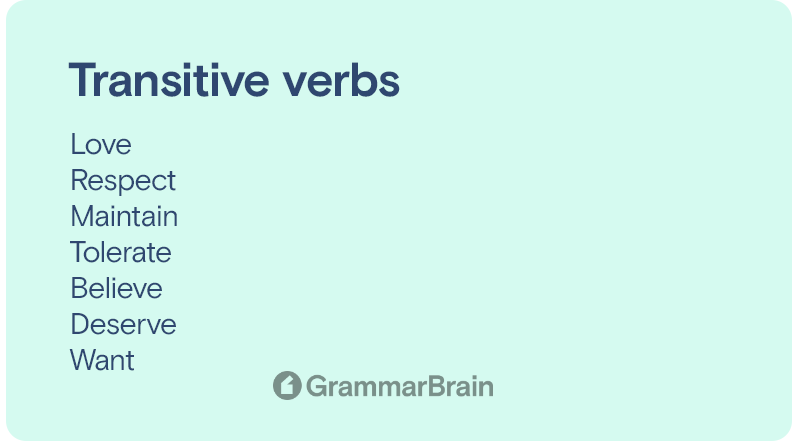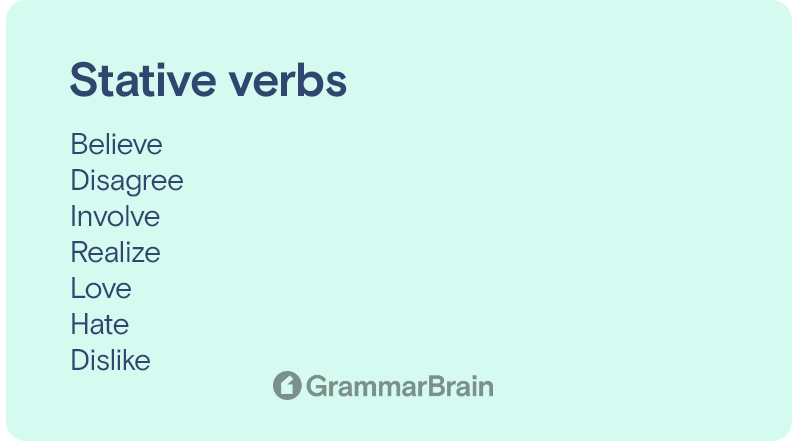What is a verb? What are the various types of verbs? A verb is one of the eight parts of speech in English that build the foundation of this language. Thus, when learning English, having a clear understanding of verbs is crucial for an individual.
This article will detail the basics of verbs, their importance, and their types.

What exactly is a verb?
The simplest definition of verbs is that “verbs are action words.”
This implies that any English word that represents an action or shows what the subject is doing is a verb. Along with describing actions, verbs also describe the subject’s “state of being.”
Why are verbs important?
Verbs are words that represent both internal actions and external actions. Examples of internal actions include words like think, love, worry, consider, etc. Similarly, examples of external actions include words like walk, jump, read, and more.
Verbs bring all the action into a sentence. It is practically impossible to do anything, to be anything, or to feel anything without a verb! Thus, verbs are considered to be one of the most important elements of the English language.
They are the only type of words that are absolutely necessary to form a logical sentence – not even nouns are that important in English. A person cannot form a complete sentence in English without a verb.
How to identify verbs in a sentence
1. One of the best ways to identify a verb in a sentence is by noticing its placement in relation to the subject. In most cases, verbs are always placed after a noun or a pronoun. These nouns and pronouns act as the subject of a sentence.
Consider the following examples:
- She went to the market.
- Robin walks quickly.
In both of these sentences, the subjects are “She” and “Robin” while the verbs (action words) are “went” and “walks.” Both of them come after the subject immediately.
2. Another excellent way to identify verbs in a sentence is by asking “Can I do it.” If the answer is yes, then that word is a verb. For example, the person can ask themselves,
- “Can I run?“
- “Can I cook?”
- “Can I speak?”
The answer to the above questions is yes. So, all of them – run, cook, speak – are verbs.
3 . Another way in which the reader can locate a verb in a sentence is by asking themselves “what is happening in the sentence?”
So, let’s consider the above-mentioned example – “Robin walks quickly.” What is happening in the sentence? Walking – Robin walks quickly. Thus, “walks” is the verb.
What are some examples of verbs?
All of us are surrounded by verbs. Since action is the heart and soul of every sentence, examples of verbs can be found everywhere.
Here are some examples of verbs to help you get a better understanding of them:
- We are building a new shelf.
- Mark is eating breakfast
- I convinced my father for an international trip.
- She is learning French
- She held onto her backpack while waiting in the queue.
- The kids are jumping up and down on the ground.
- Cole lied to his mother and got caught.
- She is preparing a presentation for tomorrow.
- Let’s go out for lunch. I am paying!
- Do you believe in ghosts?
Verb types can change based on the tense of the sentence. If the sentence is in the past tense, for example, the word formed typically change to the past participle form (-ed form). For example, the words “call” would turn into “called.” Or “love” would turn into “loved.”
Most verbs are considered regular verbs, where a “-d” or “-ed” is added to their past tense form. For example, “we walked to the grocery store.” Where the word “walk” becomes “walked.”
The present participle always ends in “-ing.” For example, “call” becomes “calling.” Or “love” becomes “loving.” The verb forms will change based on the sentence tense. For example, “I am loving this weather.” (Present tense).
Types of verbs
There are several types of verbs in the English language. Some of the major ones include the following:

1. Dynamic or action verbs
Dynamic or action verbs are verbs that are used to express specific actions. They can be used to express both external and internal actions.
Dynamic verbs can be used any number of times the writer wants to show that an activity is being performed.
Examples of dynamic or actions verbs include:
- Walk
- Swim
- Laugh
- Read
- Guess
- Grow
- Live
2. State-of-being or stative verbs
The opposite of dynamic verbs is stative verbs. These are the verbs that are used to express a subject’s state of being.
Instead of expressing actions, these verbs show a state (that is not an action). For example, they show the subject’s likes, dislikes, thoughts, emotions, etc. One of the most unique qualities of stative verbs is that they can never be used in continuous tenses.
Some common examples of stative verbs include the following:
- Believe
- Disagree
- Involve
- Realize
- Love
- Hate
- Dislike

3. Transitive verbs
Transitive verbs are verbs that are used to express doable activities that affect someone or something. They generally use direct objects but don’t always need them.
Some common examples of transitive verbs include the following:
- Love
- Respect
- Maintain
- Tolerate
- Believe
- Deserve
- Want
Tip: Transitive verbs require a direct object (a noun, pronoun, or noun phrase) to receive the action of the verb (to complete the sentence’s meaning).
4. Intransitive verbs
These verbs also express doable action or activity. The only difference between transitive and intransitive verbs is that intransitive verbs do not have a direct object following them.
Let’s have a look at some common examples of intransitive verbs:
- Laugh
- Walk
- Travel
- Sit
- Sleep
- Work
5. Auxiliary or helping verbs
As their name suggests, auxiliary verbs or helping verbs are those verbs that are used with the main verb. They help in changing the main verb’s voice, mood, or tense. Helping verbs are also referred to as “linking verbs.”
The main auxiliary verbs in English include the following:
- Have
- Be
- Do
- Could
- May
- Might
6. Modal auxiliary verbs
Modal auxiliary verbs are specifically used to express possibilities, capabilities, necessities, obligations, and permission. Just like simple auxiliary verbs, modal auxiliary verbs are also added to the main verb.
Common examples of modal auxiliary verbs include the following:
- Must
- Should
- Would
- Ought
- Should
- May
- Can
7. Phrasal verbs
Phrasal verbs are combinations of words that act as individual verbs when joined together. These words, when joined together, take on a completely different meaning than that of the original verb.
For example, consider the verb “make.” Without any other word attached to it, “make” expresses that something is being created. However, when a preposition like “up” is added to it, the phrasal verb “make up” expresses that a story is being fabricated or invented.
8. Irregular verbs
Verbs that change form in the past tense are considered irregular verbs. For example, “speak” turns into “spoke.” Or “see” turns into “saw”.
Here are example sentences, “I saw my friends the other night.”
Conclusion
Some verbs are ditransitive in nature. This means that they have two objects (direct object and indirect object). This is usually in sentences where the person is the action getting formed. For example, “Sam reads me a story.” With both an indirect object and direct object in this sentence.
Verbs are one of the most important elements of the English language. So, learning about them, understanding their nuances, and learning the art of using them in a grammatically correct way is essential.
FAQs
What is a verb and its examples?
Verbs are action words. They are used to express an action or activity. Verbs are one of the most important parts of speech in the English language.
Some examples of verbs in a sentence include the following:
- You can find the Mona Lisa painting in the Louvre Museum in Paris, France.
- Jack wants fried chicken for dinner.
- Lily doesn’t drink coke.
What are the 3 types of verbs?
There are multiple types of verbs in the English language. The three most common ones include the following:
- Dynamic or action verbs
- Stative verbs
- Auxiliary verbs
What are 10 verbs?
The ten most common verbs used in the English language are as follows:
- Take
- Come
- See
- Do
- Say
- Make
- Go
- Be
- Get
- See
How many verbs are in a sentence?
When it comes to writing in English, every sentence needs to have at least one verb. A sentence that doesn’t have even one verb is considered incomplete.
On the other hand, there is no limit to the maximum number of verbs a person can use in a sentence. Theoretically, there can be an infinite number of verbs in a sentence.
What is a verb phrase?
A verb phrase is a syntactic united that’s composed of a verb and its arguments without the subject of an independent or coordinate clause.
What is a subject-verb agreement?
A subject-verb agreement occurs when a word changes form depending on the other words it relates to. Most commonly, this is the change of words due to the sentences tense and subject.
Sources:
- Merriam-Webster Dictionary – Definition
- Grammarly – Verbs
- Ginger Software – Verbs
- Wikipedia – Verbs: Definition and Examples
Inside this article
Fact checked:
Content is rigorously reviewed by a team of qualified and experienced fact checkers. Fact checkers review articles for factual accuracy, relevance, and timeliness. Learn more.
Core lessons
Glossary
- Abstract Noun
- Accusative Case
- Anecdote
- Antonym
- Active Sentence
- Adverb
- Adjective
- Allegory
- Alliteration
- Adjective Clause
- Adjective Phrase
- Ampersand
- Anastrophe
- Adverbial Clause
- Appositive Phrase
- Clause
- Compound Adjective
- Complex Sentence
- Compound Words
- Compound Predicate
- Common Noun
- Comparative Adjective
- Comparative and Superlative
- Compound Noun
- Compound Subject
- Compound Sentence
- Copular Verb
- Collective Noun
- Colloquialism
- Conciseness
- Consonance
- Conditional
- Concrete Noun
- Conjunction
- Conjugation
- Conditional Sentence
- Comma Splice
- Correlative Conjunction
- Coordinating Conjunction
- Coordinate Adjective
- Cumulative Adjective
- Dative Case
- Determiner
- Declarative Sentence
- Declarative Statement
- Direct Object Pronoun
- Direct Object
- Diction
- Diphthong
- Dangling Modifier
- Demonstrative Pronoun
- Demonstrative Adjective
- Direct Characterization
- Definite Article
- Doublespeak
- False Dilemma Fallacy
- Future Perfect Progressive
- Future Simple
- Future Perfect Continuous
- Future Perfect
- First Conditional
- Irregular Adjective
- Irregular Verb
- Imperative Sentence
- Indefinite Article
- Intransitive Verb
- Introductory Phrase
- Indefinite Pronoun
- Indirect Characterization
- Interrogative Sentence
- Intensive Pronoun
- Inanimate Object
- Indefinite Tense
- Infinitive Phrase
- Interjection
- Intensifier
- Infinitive
- Indicative Mood
- Participle
- Parallelism
- Prepositional Phrase
- Past Simple Tense
- Past Continuous Tense
- Past Perfect Tense
- Past Progressive Tense
- Present Simple Tense
- Present Perfect Tense
- Personal Pronoun
- Personification
- Persuasive Writing
- Parallel Structure
- Phrasal Verb
- Predicate Adjective
- Predicate Nominative
- Phonetic Language
- Plural Noun
- Punctuation
- Punctuation Marks
- Preposition
- Preposition of Place
- Parts of Speech
- Possessive Adjective
- Possessive Determiner
- Possessive Case
- Possessive Noun
- Proper Adjective
- Proper Noun
- Present Participle
- Prefix
- Predicate




